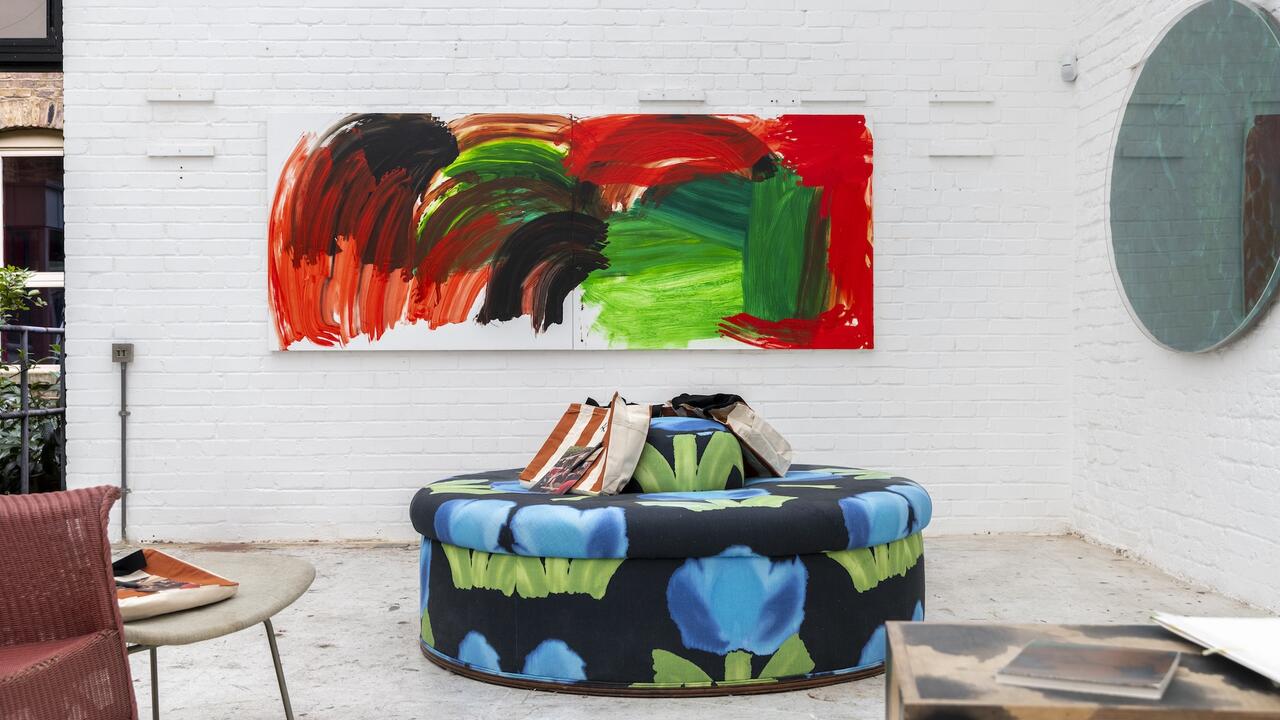Musical Chairs
Martin Kersels
Martin Kersels
The main character in Martin Kersels' cacophonous, stop-and-go drama of a recent solo show is a baby grand piano that noisily trundles from one side of the gallery to the other, digging irregular ruts in the cheaply resurfaced concrete floor as it is dragged back and forth by a cable attached to an electric winch. A few feet before crashing into one of two walls, the lurching piano grinds to a halt, having pulled its own plug like a household vacuum cleaner that's been pushed beyond the reach of its cord. Silence ensues as the enormous loudspeakers Kersels has stuffed under the piano's raised top finally stop blasting the amplified sounds of its tiny wooden wheels that had creaked, screeched and skidded under the massive musical instrument's ponderous weight.
If John Cage's altered piano presented random plinks, plangs and plunks as delightfully unpredictable music, Kersels' more aggressively adapted and electronically enhanced baby grand raises the stakes of what we might listen to. His adapted instrument eliminates the human performer altogether, allowing it to adopt a prosthetic, Frankenstein-like life all its own. The one-act performance by Kersels' piano is repeated (ad infinitum) when his dealer, Dan Bernier, stops whatever dealing he's doing, unwinds the cable, re-attaches the winch and plugs the unwieldy, white elephant of a contraption into the socket again, bringing it all back to life - only so that it can promptly pull its own plug again, committing symbolic suicide.
Entitled Piano Drag (all works 1995), this goofy, lugubrious drama recalls the endless struggles of Sisyphus, as well as Kersels' own career as a member of the performance group, The Shrimps, who from 1984-93, enacted off-balance collaborations at the boundary between theatre and everyday life. Listening to the unharmonious sounds of the piano's graceless movements - and watching the dealer repeatedly set things up - leads you to believe that the baby grand's 30-second performance isn't worth the trouble, nor Bernier's time-consuming efforts. But then you realise that the piano isn't the only actor in the artist's perverse drama - and that the time between the instrument's trips across the gallery is as important as are its noisy, tortuous travels from one wall to the other. It becomes clear that Kersels has cleverly turned the tables, profoundly reconfiguring the standard relationship between art and dealers, and implicating viewers in the process.
Standing in as a surrogate for the 6' 6", 26 stone Kersels, the gerrymandered piano recasts the superficially glamourous job of art dealer as dutiful assistant: low-level employee who performs the same uninteresting tasks over and over again, all for art's sake. In this case, art is no high-minded abstraction or idealised fantasy, but a needy, barely functional, and self-destructive instrument that is used by the stubborn artist for purposes other than those for which it was built. Piano Drag is a surreptitious power struggle that literally incorporates a dealer's dedication to art into its form, ultimately giving power back to viewers. You don't simply consume the artist's efforts; with this piece, you also get a piece of the salesman. The dealer's usual, behind-the-scenes anonymity (and control) is blown as he becomes an ordinary, unglamorous labourer in the service industry, ensuring that art keeps working - for as long as you're interested in watching, no matter how senseless its endeavours may seem.
The other character in Kersels' extravaganza is the chorus, whose mellifluous, overlapping voices chime in indeterminately to provide background music that unpredictably alters the tenor of the ongoing drama. Objects of the Dealer (with soundtracks) consists of 26 tiny loudspeakers and 13 micro-cassette players wired to 11 objects on, around and within Bernier's desk, which itself has been moved from a side office to the main exhibition space. With hundreds of feet of wire connecting the audio equipment to a wide variety of ingenious triggering switches, as well as to Bernier's computer, fax, phone, Rolodex, Filofax and tape dispenser (among other ordinary office devices), the cluttered desk looks as if it has been boobytrapped by a mad - and ineffective - bomber. The rigged work station also recalls Charles Ray's Tabletop (1989), an ordinary-looking table on top of which rotated, at an excruciatingly slow pace, a plate, glass, bowl, canister, salt shaker and potted plant. A peek beneath Ray's table revealed a bomb-like tangle of wires and electronics, suggesting the potential deadliness of slight misperceptions, and registering the rage often lurking beneath the surface of middle-class domesticity. In sharp contrast to the incipient viciousness Ray's sculpture locates, Kersels' adapted office accoutrements interrupt workaday drudgery with a bit of merriment.
Whenever Bernier used any of the wired appliances, jaunty music poured out of its speakers for as long as that tool was in use. Each micro-cassette player housed a looped tape of an animated, synthesiser-based arrangement composed by Mark Wheaton. Based on the bodily movements, rhythms and paces required by the objects to which they are attached, the soundtracks amplified the usually overlooked drama of the most mundane daily tasks. With Wheaton's playful, sometimes nutty music in the background, thumbing through your Rolodex, dashing off a fax or making a call became intense mini-dramas. Suspense and intrigue built - as did the pleasure of the otherwise unremarkable duties. The spiffy, stop-and-start melodies functioned like soundtracks for imaginary movies, transforming the boring office tasks they accompanied into starring roles. Kersels' generous piece redeemed uneventful, everyday work, a few seconds at a time. It turned forgettable activities into amusing, sometimes enchanted experiences.
Moreover, the more business Bernier did the more art he was able to enjoy - at that very moment. When he was really busy, doing a few things at once, he became something of an unwitting orchestra conductor, increasing the music's volume and complexity as he worked more swiftly. Watching and listening to Bernier's unintentionally doubled performance was like watching a frantic stockbroker make fast-paced trades as you listened to a symphony orchestra mysteriously attuned to his every activity. Art and business coalesced as Kersels filtered instantaneous gratification through the Protestant work ethic. This peculiar fusion of hard work and amusement contrasts radically with the anti-commodity, anti-business impulse of 70s Conceptualism, as well as with the fame and arrogance of the business-oriented 80s, when mega-dealers were superstars and overblown salesmanship ruled the art world.
Kersels' self-effacing works offer a new model of art's place in the commerce of life, stealthily sneaking into the picture when you least expect it, and humourously affecting actual, pedestrian experience. His fun-loving art reconciles the avant-garde with happiness - no mean feat in our mean-spirited century of hyper-self-consciousness.













